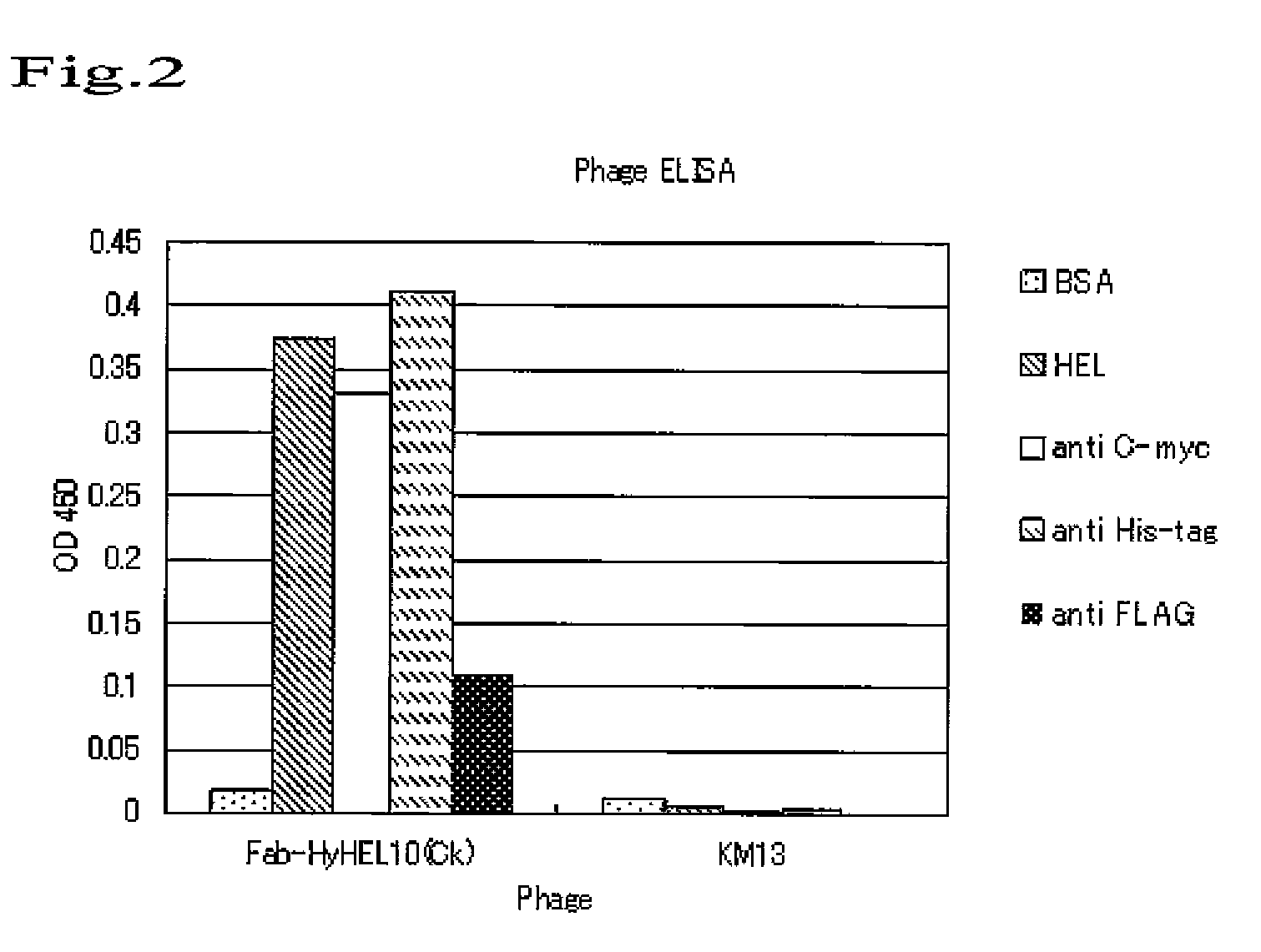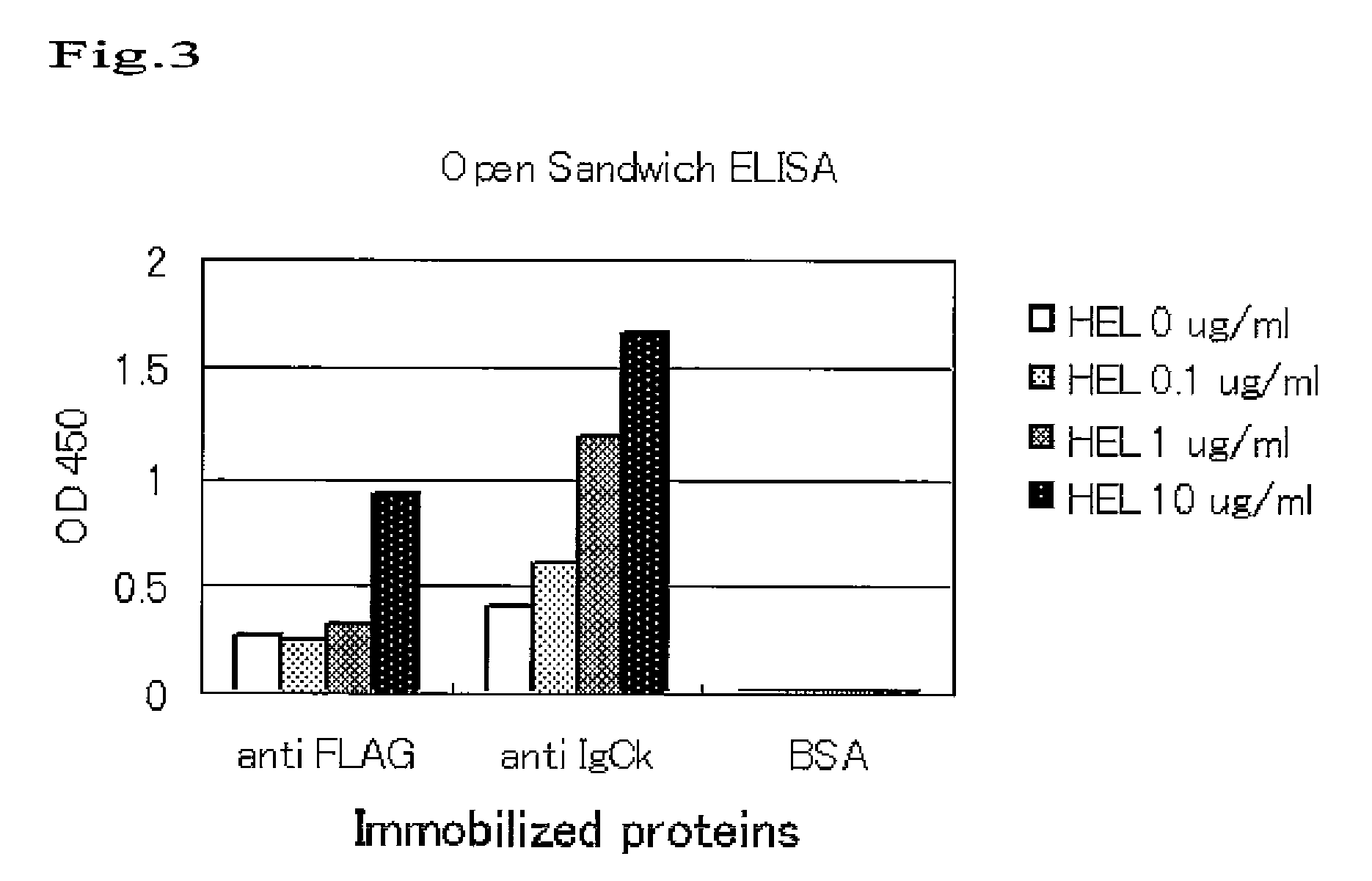Vector for screening antibody
a technology of antibodies and vectors, which is applied in the field of vectors for screening antibodies, can solve the problems of large amount of time and labor required for assays, instability of phages, and failure to express vh/vl on phages, and achieves the effect of simple and efficien
- Summary
- Abstract
- Description
- Claims
- Application Information
AI Technical Summary
Benefits of technology
Problems solved by technology
Method used
Image
Examples
example 1
Preparation of Fab Display Vector Fab / pDong
[0063]Fab-type antibody fragment display vector (Fab / pDong1) was produced as shown in FIG. 1. The primer sequences are shown in Table 1. CH1 and Ck of human Ig were used for the constant regions of the Fab fragments to be displayed, and VH and VL of a mouse antibody against hen egg-white lysozyme (HEL), HyHEL10, were used for the variable regions (VH / VL).
TABLE 1Primers used for construction of Fab type antibody fragment display systemPrimer nameSequencehgCH1EagFor:5′ -GGAATTCGGCCGACGCCGGTGAAACTTTCTTGTCCACCTTGG-3′hgCH1SgrBack:5′ -AGCTCACCGGCGTCCACCAAGGGCCCATCGGTC-3′spH10VHSgrFor:5′ -GGTGGACGCCGGTGAGCTCGAGACGGTGACCGTGG-3′M13RV:5′ -GGAAACAGCTATGACCATG-3′FdLoxP511Back:5′ -GCTCTAGAAGCTTATAACTTCGTATAATGTATACTATACGAAGTTATTTCAAGGAGACAGTCATAATG-3′G3LoxP2272XbaFor:5′ -CAGCTCTAGATAACTTCGTATAAGGTATCCTATACGAAGTTATTAAGACTCCTTAT-3′hCkNotBack:5′ -GGAATTCGCGGCCGCAGGCGCGCCATCTGTCTTCATCTTCCC-3′hCkNarFor:5′ -GGAATTCGGCGCCTTGGCGCGCCTTAGCACTCTCCCCTGTTGAAGC-3′pHE...
example 2
Confirmation of Antigen Binding Ability by Phage ELISA
[0068]The binding ability of HyHEL10-derived Fab antibody display phage that had been prepared so far by infection of E. coli TG-1 transformant of Fab / pDong1 with helper phage KM13, for the antigen and respective tagged antibodies, was confirmed by ELISA.
[0069]That is to say, E. coli TG-1 transformant of Fab / pDong1 was added to 10 ml of LB medium (100 μg / ml ampicillin and 1% glucose) and cultured at 37° C. until OD600 reached about 0.4. Helper phage KM13 (2×1011 pfu) was added thereto. The mixture was left still at 37° C. for 30 minutes, centrifuged (at 3,000 g for 10 minutes), and resuspended with 50 ml of LB medium (100 μg / ml ampicillin, 50 μg / ml kanamycin, and 0.1% glucose). The culture solution was transferred into a baffled Erlenmeyer flask, and incubated at 230 rpm at 30° C. After overnight incubation, bacteria were removed by centrifugation at 3,000 g for 30 minutes. About 40 ml of supernatant containing Fab display phage ...
example 3
Panning of Model Libraries
[0071]In order to confirm that the Fab display phage of this system is applicable to panning of libraries, panning was carried out with model libraries.
[0072]The model libraries were produced by mixing 2.0×108 cfu of HyHEL10 Fab display phage and 1012 cfu of 13CG2 scFv display phage (phage displaying ScFv of anti-BS antibody) that had been produced in the same manner as the above. 3.6 ml of NaHCO3 solution (pH 9.6) containing 10 μg / ml HEL was put into an immuno tube (Nalge Nunc International K.K., Rochester, N.Y.) and left still at 4° C. for 16 hours to immobilize antigens. After washing with PBS three times, blocking was performed with MPBS at room temperature for 2 hours. After washing with PBS three times, the tube was poured with 3.6 ml of solution containing 5.0×1011 cfu of model library phage, and was rotated for 1 hour and left still for 1 hour at room temperature to immobilize these phages. After discarding the phage solution, the tube was washed wi...
PUM
| Property | Measurement | Unit |
|---|---|---|
| temperature | aaaaa | aaaaa |
| temperature | aaaaa | aaaaa |
| temperature | aaaaa | aaaaa |
Abstract
Description
Claims
Application Information
 Login to View More
Login to View More - R&D
- Intellectual Property
- Life Sciences
- Materials
- Tech Scout
- Unparalleled Data Quality
- Higher Quality Content
- 60% Fewer Hallucinations
Browse by: Latest US Patents, China's latest patents, Technical Efficacy Thesaurus, Application Domain, Technology Topic, Popular Technical Reports.
© 2025 PatSnap. All rights reserved.Legal|Privacy policy|Modern Slavery Act Transparency Statement|Sitemap|About US| Contact US: help@patsnap.com



